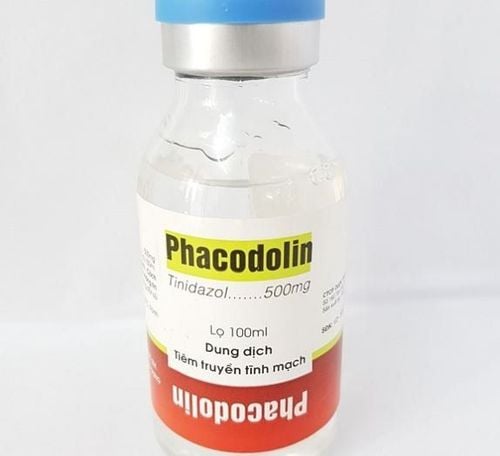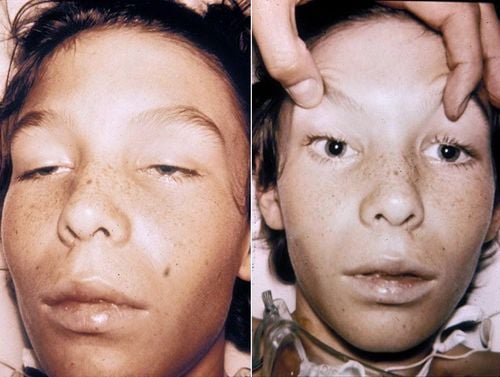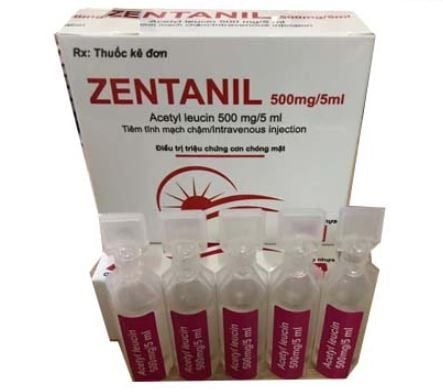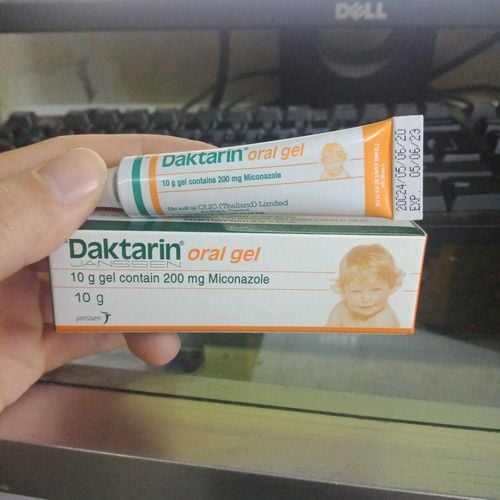This is an automatically translated article.
Posted by Specialist Doctor II Pham Thi Khuong - Infectious Doctor - Pediatric Center - Vinmec Times City International Hospital
Botulism is caused by the toxin of Clostridium botulinum and affects the peripheral nervous system. Patients can acquire botulism without causing disease if the toxin is swallowed, injected, or inhaled. Symptoms include symmetric cranial nerve palsy with bilateral weakness and flaccid paralysis without sensory disturbances. Diagnosis is by clinical and laboratory findings for toxins. Supportive and antitoxin therapy.
1. Food poisoning
Food poisoning is caused by eating food contaminated with preformed botulinum toxin. Toxins A, B, and E have all been implicated in food poisoning.
1.1. Source of toxins
Canned foods, especially foods with low acidity (pH > 4.5) are the most common source of gastrointestinal toxicity; Commercially processed foods are implicated in about 10% of outbreaks. Vegetables (usually not tomatoes), fish, fruits and spices are the most common means of disease transmission; Beef, dairy products, pork, poultry and other foods can also cause illness. In outbreaks caused by seafood, type E causes about 50%; Types A and B cause the rest. In recent years, non-canned foods (eg, baked potatoes, deep-fried minced garlic, sandwiches) have caused restaurant-related outbreaks. In the United States, the highest rates of food poisoning have been reported among Alaska Natives due to the perennial consumption of fish and cetaceans. Surveillance data from the U.S. Centers for Disease Control and Prevention (CDC) from 1947 to 2007 show an average annual incidence of 6.9 cases per 100,000 Native Alaskans compared with nationwide is 0.0068 cases per 100,000 people. Type E toxins are the most commonly associated with food poisoning in Alaska.
Sometimes toxins are absorbed through the eyes or open wounds in the skin. Such cases often cause serious illness. C. botulinum spores are common in the environment; Most cases of botulism in infants are caused by ingestion of spores, especially honey.
Spores can also enter the body when drugs are injected with a non-sterile needle; The wound may be infected with botulism. Injecting contaminated heroin into the muscle or under the skin (irritated skin) is the greatest risk; It can cause gaseous gangrene such as botulism. If botulinum toxin enters the bloodstream, it causes poisoning, regardless of the route of contamination.

Trẻ sơ sinh ăn mật ong có nguy cơ nhiễm C. botulinum
Commercial and restaurant products are sometimes a source of supply; Specific commercial sources include improperly refrigerated carrot juice and sausages. In Vietnam from August 31, 2020, according to TS.BS Nguyen Trung Nguyen - Director of the Poison Control Center, Bach Mai Hospital, said: Currently, the Center has received 2 hospitalized patients for inpatient treatment. and 4 other patients came to the clinic because of botulinum toxin-related food poisoning. All of these cases used Minh Chay pate food. On September 3, 6 more patients (patients) after using Pate Minh Chay. Specifically, 2 patients in Khanh Hoa, 2 patients in Dong Nai and 2 patients in Ba Ria - Vung Tau. Up to the beginning of this September, in Vietnam, more than 20 people have been examined or hospitalized for signs of infection with Clostridium botulinum bacteria found in Minh Chay pate.
1.2. Wound Poisoning
C botulinum can cause wound infection and subsequent neurotoxin production in vivo. In theory, wound poisoning should only involve puncture wounds, subcutaneous abscesses, and deep cavity infections, which provide the necessary anaerobic environment for spores to germinate and organisms to grow. Accordingly, wound poisoning is related to injection drug use, especially "opium" and subcutaneous or intramuscular injection. Recurrent wound botulism has occurred in some people who inject drugs.
However, cases have also been described involving abrasions, lacerations, open fractures, incisions and even closed hematomas without significant skin defects. One case has been reported of pelvic abscess, paralysis, and hematologic toxicity due to C. botulinum following laparoscopic appendectomy.
Wound poisoning has also been reported in patients who inhaled cocaine. The patient had sinusitis, in which one patient developed C. botulinum from sinus aspiration.
In physician-associated botulism, type A toxin is acquired during therapeutic injections to relieve excessive muscle tension; Intoxication occurring after cosmetic injection (with botulinum toxin) has occurred but is rare.
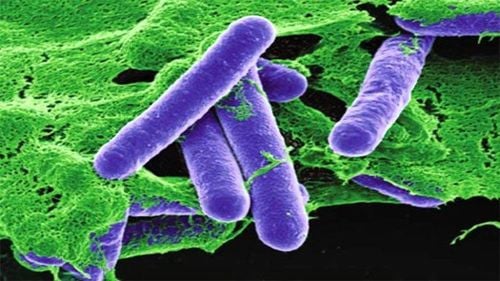
C botulinum có thể gây nhiễm trùng vết thương
2. Bioterrorism-related botulism
C. botulinum toxins are the most potent toxins known, and there has been growing interest in them as agents of bioterrorism. The 1972 Biological and Toxic Weapons Convention prohibits the research and production of biological weapons, although it is widely believed that Iran, Iraq, North Korea, and Syria have sources of botulinum toxin intended for domestic terrorism. sponsoring country. Despite the potency of this poison, its application as a weapon of bioterrorism has been hampered by the technical complexity of concentrating and stabilizing the poison to create aerosols.
The presumed mode of transmission for botulism associated with bioterrorism is inhalation of aerosol poisons, although gastrointestinal transmission is also a possible mode of attack. It is estimated that inhalation of aerosolized botulinum toxin leads to acute diminished symmetrical flaccid paralysis with prominent limb paralysis (diplopia, dysesthesia, dysphagia, and dysphagia) after 12 to 72 hours.
Common signs and symptoms of botulism include:
Dry mouth Blurred or double vision Eyelid inflammation Slurred speech Difficulty swallowing Light reflexes are reduced or completely absent. Difficulty swallowing can lead to aspiration pneumonia. The typical neurological symptoms are bilateral and symmetrical, beginning with cranial nerve palsies and then progressively weakening or paralyzing.
There is no sensory disturbance, and the sensation is still clear. Gradual weakness from the distal and trunk and respiratory muscles. Usually no fever, normal or slow pulse, unless other infections are present. Constipation is a common symptom after intestinal smooth muscle paralysis.
Major complications of botulism include:
Respiratory failure due to diaphragmatic paralysis Nosocomial infections: Nosocomial pneumonia or other acquired infections.

Suy hô hấp là một biến chứng của bệnh nhiễm độc botulism
3. According to disease type
3.1. Food poisoning
Symptoms begin suddenly, usually 12 to 36 hours after ingestion of the toxin, although the incubation period can vary from several hours to 14 days.
Common early manifestations are: Nausea, vomiting, abdominal pain and diarrhea, then new neurological symptoms appear. Paranoid symptoms usually include nausea, vomiting, abdominal pain, diarrhea, and dry mouth with sore throat before developing cranial neuropathy and diminishing weakness, but these symptoms can occur at any time. at any time during the course of the illness. Manifestations of the disease can vary from mild complaints to death within the first 24 hours after the development of symptoms. In other mild cases, ocular cranial nerve palsy is uncommon or rarely the sole manifestation of the disease.

Nôn và buồn nôn là những triệu chứng của ngộ độc thực phẩm
3.2. Infectious diseases from wounds
Neurological symptoms appear similar to those in food poisoning, but there are no gastrointestinal symptoms or food-related evidence. A history of trauma or a deep puncture wound (especially if injecting drugs) within the previous 2 weeks may suggest the diagnosis.
It is necessary to carefully examine cases with open wounds on the skin surface and cases of skin abscesses caused by injection drugs.
Onset: Usually symptomatic and may be related to cranial nerve damage including blurred vision (secondary to fixed pupillary dilation and cranial nerve palsies III, IV, and VI) common in adults, diplopia, nystagmus, hemiparesis, dysphagia, cardiac arrhythmias, and facial weakness. The most common clinical manifestations in children are dysphagia, gastrointestinal disturbances, and general weakness. Descending muscle weakness often progresses to the trunk and upper extremities, then the lower extremities. Urinary retention and constipation are common due to smooth muscle paralysis. Paresthesias and asymmetrical weakness are sometimes seen. Shortness of breath (eg, dyspnea) requiring intubation and mechanical ventilation is common, and due to diaphragmatic paralysis, upper airway injury, or both. Approximately 40 percent of patients presented at the time of admission with a respiratory-related condition (dyspnea or respiratory failure); Of those, only 42 percent had evidence of excessive weakness at the time. Nonspecific gastrointestinal symptoms may also be present and are sometimes the predominant manifestations. Although there is evidence of neurological involvement, cerebrospinal fluid disturbances are rare. Elevated cerebrospinal fluid protein is sometimes seen.
Please dial HOTLINE for more information or register for an appointment HERE. Download MyVinmec app to make appointments faster and to manage your bookings easily.
References
1.P Samuel Pegram, MD, FACP; Sean M Stone, MD. Botulism; 2020 UpToDate, Inc. and/or its affiliates. All Rights Reserved
2.Guidelines for the diagnosis and treatment of musculoskeletal diseases
(Issued together with Decision No. 361/QD-BYT of January 25, 2014 by the Minister of Health) 3.Zingnews.E-Journal. Online Knowledge.Management agency:Vietnam Publication Association.Press license: No. 75/GP-BTTTT




